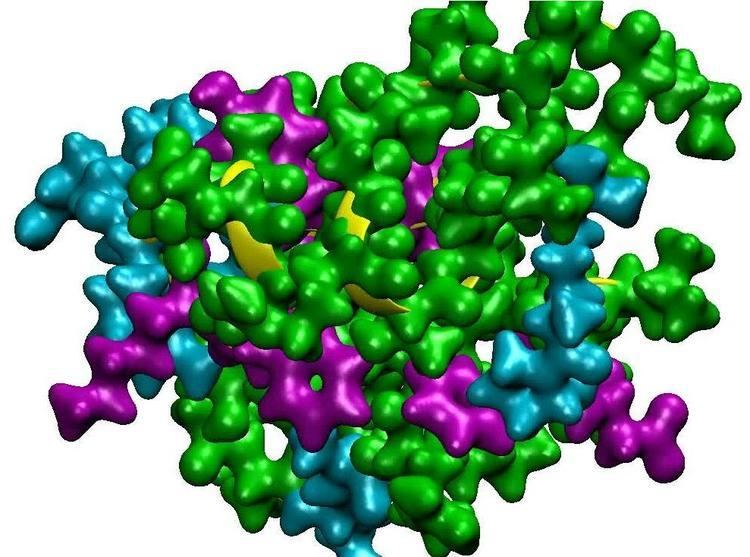 | ||
The Explicit Polarization (X-Pol) Theory is both a fragment-based electronic structure method and a quantal force field for macromolecular systems.
Contents
Definitions
The explicit polarization (X-Pol) theory is a fragment-based electronic structural method for macromolecular simulations, introduced by Jiali Gao in 1997. In this method, a condensed phase system is partitioned into individual subsystems, called fragments or blocks, which can be an individual molecule, a residue, a molecular fragment, a group of molecules and residues, or a subset of the atomic orbitals on a single atom or on a group of atoms. The molecular wave function of the entire system is a Hartree product of the antisymmetrized wave functions of the individual blocks. Consequently, the X-Pol method naturally accounts for the mutual polarization in the system, and leads to linear scaling with respect to the number of partitioned blocks in electronic structure calculations. Furthermore, the individual wave functions of the subsystems can be obtained at any level of theory—ab initio Hartree–Fock (HF), semiempirical molecular orbital theory, correlated wave function theory, or Kohn–Sham (KS) density functional theory (DFT).
Uses and demonstrations
Although the X-Pol method can be used as an electronic structural approach for studying intermolecular interactions, the most significant is that the X-Pol potential provides a general theoretical framework for development of next-generation force fields in condensed-phase and macromolecular simulations using electronic structural methods explicitly, going beyond the traditional molecular mechanics as developed by Terrell Hill and F. H. Westheimer for organic molecules and the Lifson force fields for biological systems. The computational algorithm, feasibility and accuracy of the X-Pol potential have been demonstrated through statistical mechanical Monte Carlo simulations of liquid water, with the computed heat of vaporization and liquid density within 1% and 3% of experiments, respectively. The X-Pol method has been illustrated to be feasible for extensive molecular dynamics simulations of fully solvated proteins under periodic boundary conditions. The X-Pol method can be used to perform 3,200 full energy and analytical gradient evaluations in molecular dynamics simulation of a sovated Bovine Pancreatic Trypsin Inhibitor (BPTI) protein in water, consisting of nearly 15,000 atoms and 30,000 basis functions, on a single 1.6 GHz processor in one day, in 2008.
Basis of the theory
The X-Pol theory is based on a hierarchy of three levels of approximations: (1) the construction of the total molecular wave function as a Hartree product of the antisymmetric wave functions of individual blocks, (2) the treatment of the inter-block Coulomb interactions, formally the two-electron four-center integrals, by the use of a classical multipole approximation of the external electrostatic potential, and (3) an approximate representation of the short-range exchange repulsion and long-range dispersion interactions. The X-Pol method is a general theoretical approach such that the individual subsystems can be treated by a single Slater determinant wave function method at the ab initio or semiempirical level, a multi-configurational self-consistent field (MCSCF) or configuration interaction (CI) method, a perturbation theory, and density functional theory.
Procedures and approaches
A double self-consistent field (DSCF) algorithm was initially proposed in 1997 for Monte Carlo simulations. In this procedure, the wave function of each subsystem is optimized in the presence of the Coulomb field of the rest system, and then, the total energy of the entire system is optimized self-consistently. Later, this method was adopted to create a Fragment molecular orbital model in 1999. However, the DSCF approach was not fully variational, making the computation of analytical gradients exceedingly time-consuming. This was not a problem in the initial aim of carrying out statistical mechanical Monte Carlo simulations of liquids since the energy difference between the DSCF and variational results is negligible, but it is impractical in structural optimization of macromolecular systems and molecular dynamics simulations. Unlike other approaches that do not have a system wave function coupled with ad hoc (inconsistent) energy addition-subtraction corrections, a fully variational X-Pol method has been described, and its computational efficiency was illustrated in the above example of molecular dynamics simulations of a fully solvated protein in water.
The X-Pol method has been implemented into the program CHARMM.
